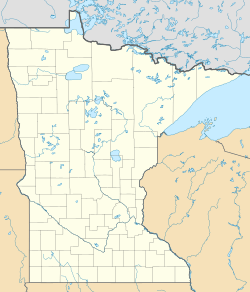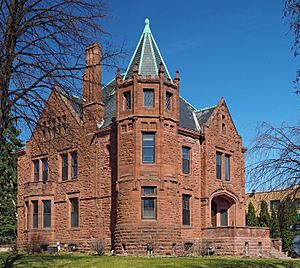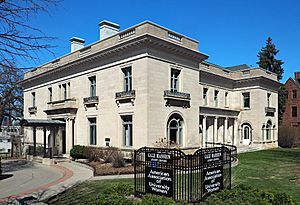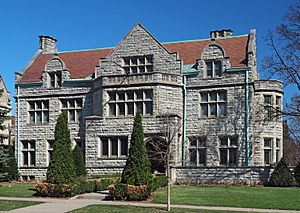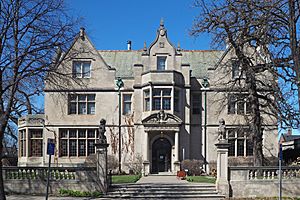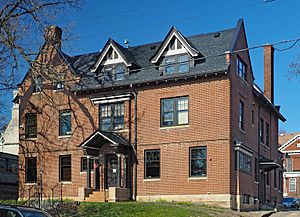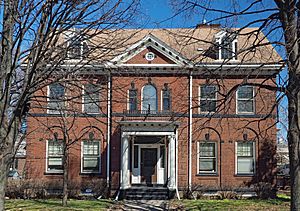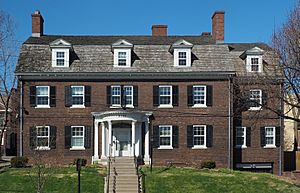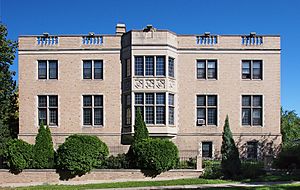Washburn-Fair Oaks Mansion District facts for kids
Quick facts for kids |
|
|
Washburn-Fair Oaks Mansion District
|
|
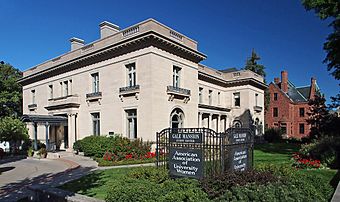
Two mansions in the Washburn-Fair Oaks Mansion District
|
|
| Location | 1st and 2nd Avenues, 22nd Street, and Stevens Avenue, Minneapolis, Minnesota |
|---|---|
| Area | 4 acres (1.6 ha) |
| Architect | William Channing Whitney |
| Architectural style | Classical Revival, Renaissance |
| NRHP reference No. | 78001544 |
| Added to NRHP | February 17, 1978 |
The Washburn-Fair Oaks Mansion District is a special historic area in Minneapolis, Minnesota. It's located in the Whittier neighborhood, right around Washburn-Fair Oaks Park. This district is famous for its beautiful old mansions. The city of Minneapolis has marked a larger area as a historic district. A smaller part of this district, which includes seven mansions, is listed on the National Register of Historic Places. This means these buildings are important to the history of the United States.
Contents
- Discovering the Washburn-Fair Oaks Mansion District
- Famous Mansions in the District
- Eugene Merrill House: Oldest Mansion
- Gale Mansion: A Modern Marvel
- Alfred F. Pillsbury House: Art Collector's Home
- Charles S. Pillsbury House: Grand Entrance
- John Crosby House: General Mills Connection
- Caroline Crosby House: Georgian Style
- Luther Farrington House: Youth Mentoring Center
- Hennepin History Museum: A Historic Home
Discovering the Washburn-Fair Oaks Mansion District
This area became popular because wealthy families wanted to build big, fancy homes. They moved away from the busy city center to what was then the edge of town. Building started in the early 1870s and continued until about 1930. The houses here show off many popular architectural styles from that time.
The park itself is named after a huge mansion called Fairoaks. This mansion was built in 1884 by E. Townsend Mix. Fairoaks was one of the grandest homes in the Twin Cities back then. It had 40 rooms and sat on a huge, beautiful piece of land. The mansion belonged to William D. Washburn, a lawyer who became very rich from his family's milling business. After he passed away in 1912, he gave the mansion to the Minneapolis Park Board. But it was too expensive to keep up, so it was torn down in 1924.
The Minneapolis Institute of Art building is just south of the park. This spot used to have the Dorilus Morrison house. It was built in 1858 by a lumberman who became Minneapolis's first mayor. His son, Clinton Morrison, later gave the family estate to the Minneapolis Society of Fine Arts. The old house was taken down in 1911. The Minneapolis Institute of Art, designed by a famous New York firm, was finished in 1915. Today, many young professionals and artists live in the neighborhood around the mansion district.
Famous Mansions in the District
Eugene Merrill House: Oldest Mansion
The Eugene Merrill House is at 2116 Second Avenue South. It was built in 1884 for Eugene Merrill, a banker and lawyer. The house was designed by William Channing Whitney. This is the oldest mansion in the district. It has rough red sandstone walls and a unique tower. These features are typical of the Richardsonian Romanesque style. Today, it is an office building.
Gale Mansion: A Modern Marvel
The Gale Mansion is located at 2115 Stevens Avenue South. It was built in 1912 in the Renaissance Revival style. The land for this house was bought for only $50 in 1855! The owner, Edward Chanary Gale, was the son of a Minneapolis real estate pioneer. His wife, Sara Bell Pillsbury, was the daughter of Governor John S. Pillsbury.
The house is covered in beautiful Bedford limestone. It had many modern features for its time. These included a central vacuum system and a kitchen on the main floor, not hidden in the basement. It also had an intercom system. The house was heated by a coal furnace, so the decorative fireplaces were rarely used. In the garden, there is a fountain with a sculpture called Boy with a Duck. The American Association of University Women now owns this house.
Alfred F. Pillsbury House: Art Collector's Home
The Alfred F. Pillsbury house is at 116 22nd Street East. It was designed in a Tudor Revival style. The house is faced with rough, locally sourced limestone. Alfred F. Pillsbury was the only son of John S. Pillsbury. He was a famous art collector. He collected many Chinese jade pieces, which you can now see at the Minneapolis Institute of Art.
Charles S. Pillsbury House: Grand Entrance
The Charles S. Pillsbury House is at 100 22nd Street East. It is also in the Tudor Revival style. This house has a special glass room for plants and detailed carvings. Two lion statues guard its entrance gate. Charles S. Pillsbury was the son of Charles Alfred Pillsbury, who founded the Pillsbury Company. An organization that helps people who are blind now owns this house.
John Crosby House: General Mills Connection
The John Crosby House is at 2104 Stevens Avenue South. It was built in 1904 for John Crosby. He was a co-founder of the Washburn-Crosby Company, which later became General Mills. William Channing Whitney designed this house in the Colonial Revival style.
Caroline Crosby House: Georgian Style
The Caroline Crosby House is at 2105 First Avenue South. It was built by the daughter of John Crosby. This house is a brick Georgian Revival building. It now serves as the main office for the Institute for Agriculture and Trade Policy.
Luther Farrington House: Youth Mentoring Center
The Luther Farrington House is at 2100 Stevens Avenue South. It is also built in the Georgian Revival style. This building is now known as the Hartwell Center for Mentoring. It was named after John and Lucy Hartwell, who were related to the Crosby family. They bought the building and gave it to the Minneapolis Jaycees. It was then sold to Bolder Options, a local program that helps mentor young people.
Hennepin History Museum: A Historic Home
The Hennepin History Museum is located in what was once the George H. and Leonora Christian House. It was designed by local architects Hewitt and Brown. The house has Renaissance Revival features, like a decorative railing on the roof. George Christian was a manager at the Washburn-Crosby milling company. He helped improve how flour was made, which made Minneapolis flour very popular.
Sadly, before the house was finished, George Christian, his wife, and his son passed away. Carolyn McKnight Christian, the younger Christian's widow, lived in the house for forty years with seven servants and three foster children. This building is now home to the Hennepin History Museum.


